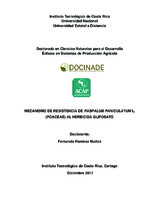Mecanismo de resistencia de Paspalum Paniculatum L. (Poaceae) al Herbicida Glifosato
Resumen
Paspalum paniculatum is a perennial herbaceous grass species originating from
South America. It is of economic importance as a weed in plantation crops where
glyphosate is widely used in its control. Glyphosate is a broad spectrum herbicide
and its activity is due to the inhibition of the enzyme 5-enolpyruvylshikimate-3-
phosphate synthase (EPSPS) responsible for aromatic amino acids and other
important substances synthesis in plants. A diagnosis of herbicides used in
perennial crops showed glyphosate is the most used pesticide in palm heart (91%
of total of pesticides and 93% of total herbicides with 2.74 kg a.i. ha-1), in citrus
(51% and 78% respectively with 2.68 kg a.i. ha-1) and in oil palm (64% and 66%
respectively 4.24 kg a.i. ha-1). Reduced control by glyphosate at its recommended
field rate (910 g a.e. ha-1) has been observed in palm (for hearts) and banana
crops in the Caribbean region of Costa Rica in fields exposed for more than a
decade to multiple applications per year. The main objective of the study was to
characterize glyphosate resistance mechanisms in resistant (R) biotypes.
Greenhouse dose–response bioassays carried out in 2012-2014 confirmed that
putative R plants with 5 leaves and no tillers (stage I) were indeed three to eight
fold less sensitive to glyphosate, and plants with one to three tillers (stage II) were
two to five fold less sensitive than known susceptible (S) biotypes. Glyphosate
absorption, translocation (to different parts of the plant) and exudation measured
with radio labeled C14 glyphosate and phosphor imaging were similar in both R and
S biotypes for both grown stage. Glyphosate and AMPA, its main metabolite, were
determined by LC-MS/MS in R plants sprayed with 1.0 kg a.e. ha-1 and in
untreated controls. AMPA were found in any sample, but glyphosate residues
were found at high levels (25 to 33 ppm) in tissues of treated plants, indicating that
differential metabolism of the herbicide does not confer resistance. Plants from
representative individual S and R biotypes were treated with glyphosate (0.72 kg
a.e. ha-1) and shikimic acid was extracted 6, 24, 48, 72, 96 and 144 h after
4
treatment (hat), The S biotypes accumulated between five and eight times more
shikimic acid than did the R biotypes at 6 and 144 hat; also discs plants were
treated with different glyphosate concentrations and measured 24 hat, S biotypes
accumulate more shikimato than R at low doses 15,6 μM (7 fold), 31 μM (10 fold),
63 μM (5 fold), 125 μM (3 fold) than at high doses 250 and 500 μM (2 fold),
suggesting that the resistance mechanism is an active site type. EPSPS was
extracted in order to measuring protein concentration (gene copy number) and
enzymatic activity. Both resistant and susceptible biotypes had low and similar
EPSPS copy, thus gene amplification is not the resistance mechanism. The protein
extraction quantities were not enough to complete the EPSPS activity experiments.
Sequencing of the EPSPS gene found a double single amino acid substitution at
position P106L that made the enzyme insensitive to glyphosate by assumed a
condensed conformation results in changes in the distance between amino acids,
and the substitution V332A that partially restores the conformation of the binding site
for Shikimate-3-phosphate that was affected by the P106L mutation, suggesting that
mutation on EPSPS gene is the responsible for P. paniculatum resistance to
glyphosate. The conclusion is: resistance in P. paniculatum biotypes of Costa Rica
is due a target site double mutation.
Descripción
Tesis (Doctorado en Ciencias Naturales para el Desarrollo énfasis en Sistemas de Producción Agrícola). Instituto Tecnológico de Costa Rica. Universidad Nacional de Costa Rica. Universidad Estatal a Distancia, Doctorado en Ciencias Naturales para el Desarrollo, 2017


